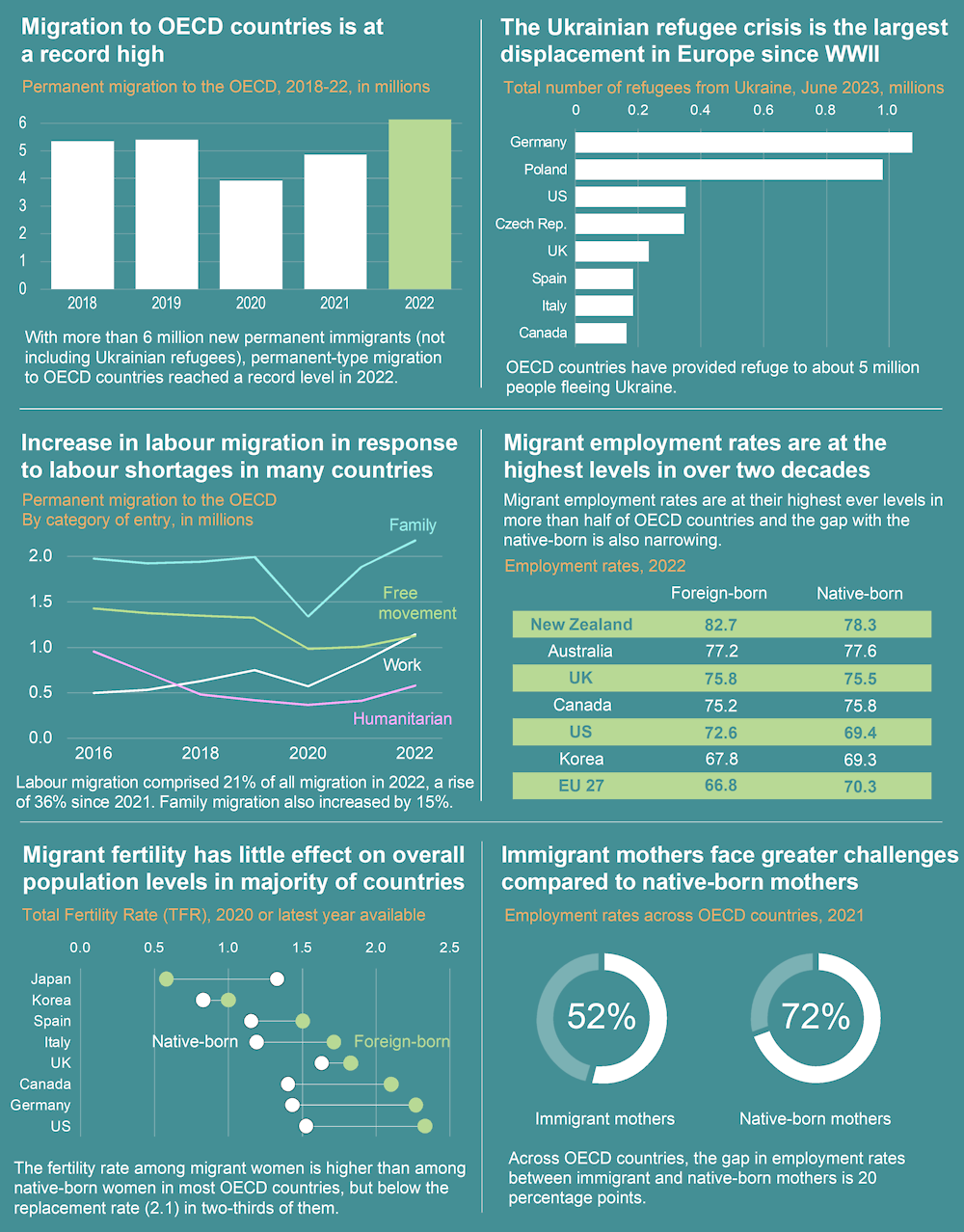International Migration Outlook 2023 | 26 Oct 2023
For Prelims: International Migration Outlook 2023, Organisation for Economic Co-operation and Development (OECD), Latin America, Climate-Induced Displacement
For Mains: Similarity and interrelationship of migration to OECD countries with internal or intra-state displacement and migration in India, Demography.
Why in News?
Recently, International Migration Outlook 2023, a report on international migration patterns was released by the Organisation for Economic Co-operation and Development (OECD) to analyze the migration trends worldwide.
What are the Highlights of the Report?
- India Leads in Migration to OECD Countries:
- In 2021 and 2022, India became the primary source of migration to OECD countries, surpassing China. India consistently topped the list with 0.41 million new migrants in both years, while China had 0.23 million new migrants, followed by Romania with approximately 200,000 new migrants.
- Climate-Induced Displacement and Policy Responses:
- The report sheds light on the increasing focus on policy responses to climate-induced displacement in recent years. Few OECD countries have explicit policies to address this issue.
- Notably, Colombia began discussing a pioneering bill in April 2023, aiming to recognize and support climate-displaced individuals, with a broad definition and provisions for housing, healthcare, education, and a national register.
- Record Refugee Inflows and Worker Migration:
- The OECD region experienced record refugee inflows due to the Russia-Ukraine war, with over 10 million people becoming internally displaced or refugees. Worker migration saw significant increases from India, Uzbekistan, and Turkey, making them prominent source countries following Ukraine.
- Recent Trends in International Migration:
- All top four destination countries (The United States, Germany, the United Kingdom and Spain) registered large year-on-year increases, between 21% and 35%. The increase was smaller in Canada (8%) the fifth destination country.
- The United States alone accounted for 1.05 million new permanent-type migrants, and the other four countries for between 440 000 and 650 000 each.
- Permanent-Type Migration by Main Categories:
- In 2022, family migration remained the primary category of entry for new permanent-type migrants, representing 40% of all permanent-type migration, a relatively stable share over time.
- The share of labour migration has increased over time. While in 2022, labour migration represented 21% of permanent-type migration, it accounted for only 16% in 2019.
- Conversely, the share of free movement migration (within the EU-EFTA and between Australia and New Zealand) has decreased since 2020. It accounted for 21% of permanent-type migration in 2022, compared with 28% in 2019.
What is OECD?
- About:
- The OECD is an intergovernmental economic organisation, founded to stimulate economic progress and world trade.
- Most OECD members are high-income economies with a very high Human Development Index (HDI) and are regarded as developed countries.
- Foundation:
- It was founded in 1961 with its Headquarters at Paris, France and total membership is 38 countries.
- The most recent countries to join the OECD were Colombia, in April 2020, and Costa Rica, in May 2021.
- India is not a member, but a key economic partner.
- Reports and Indices by OECD:
- Government at a Glance
- OECD Better Life Index.
UPSC Civil Services Examination Previous Year Question (PYQ)
Mains:
Q. “Refugees should not be turned back to the country where they would face persecution or human right violation”. Examine the statement with reference to the ethical dimension being violated by the nation claiming to be democratic with open society. (2021)
Q. Rehabilitation of human settlements is one of the important environmental impacts which always attracts controversy while planning major projects. Discuss the measures suggested for mitigation of this impact while proposing major developmental projects. (2016)
Q. Discuss the changes in the trends of labour migration within and outside India in the last four decades. (2015)

